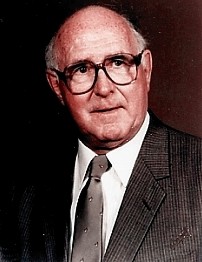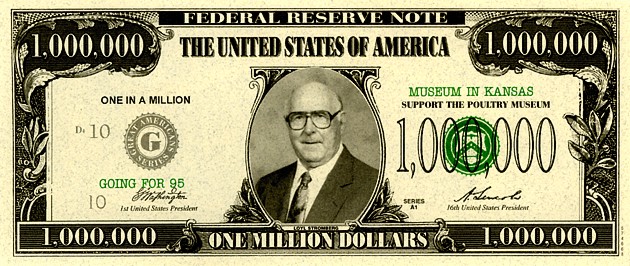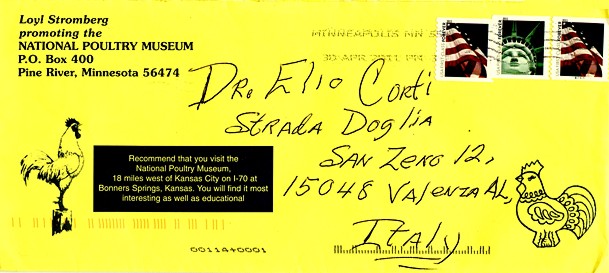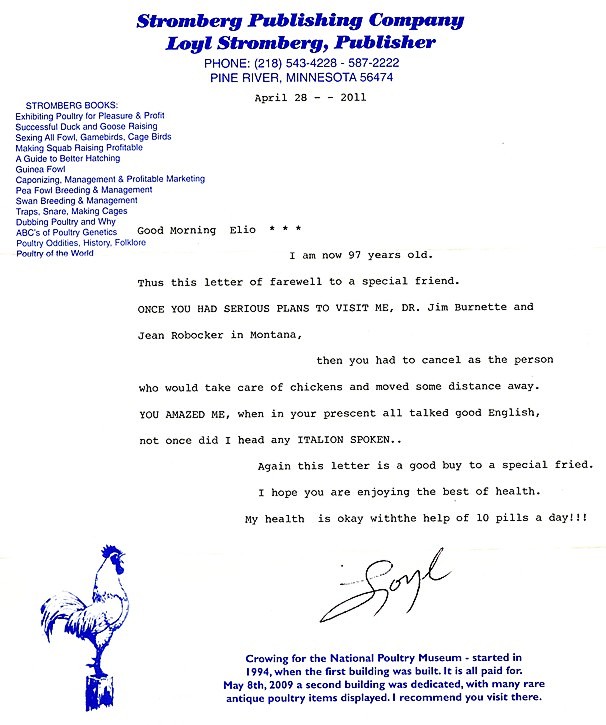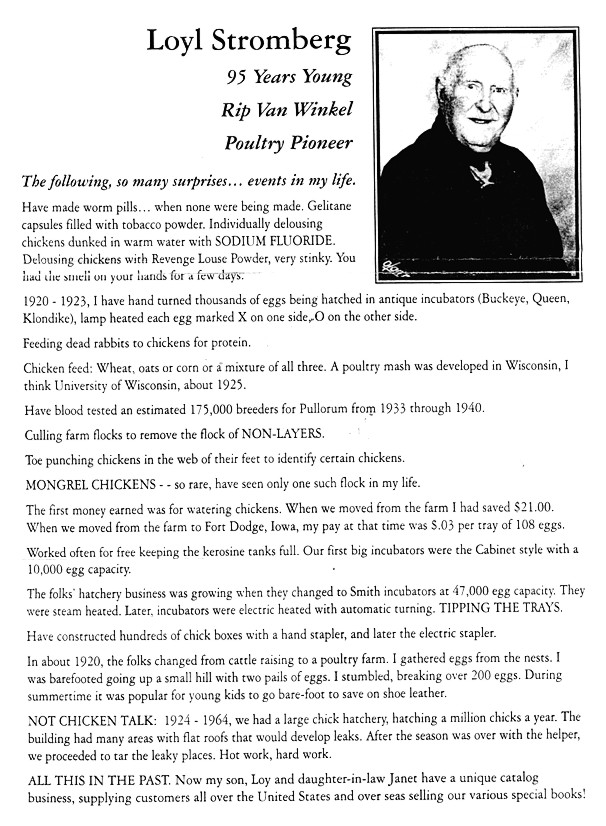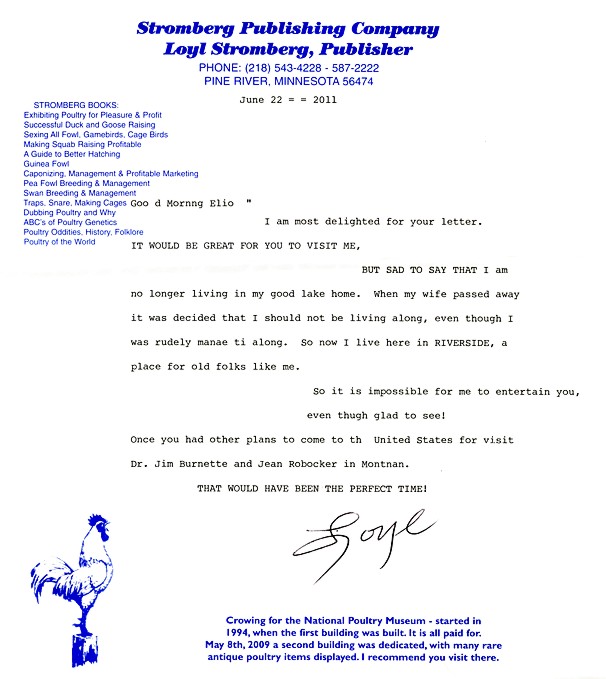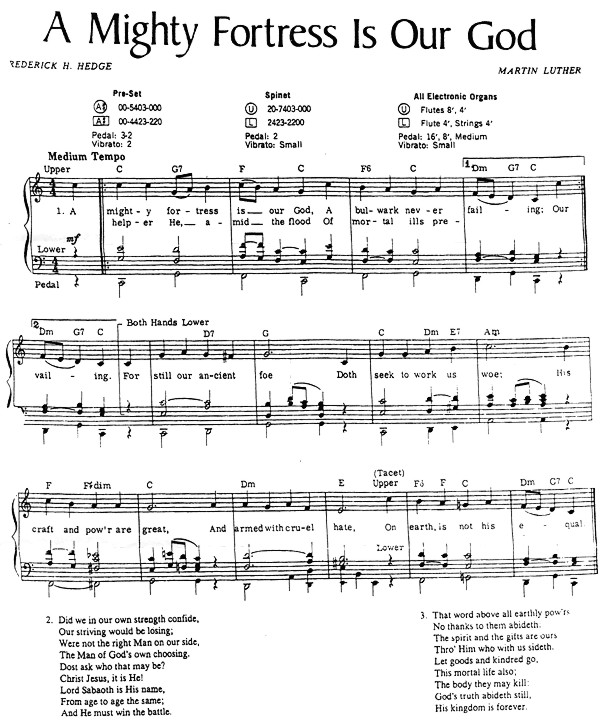Loyl StrombergLoyl Stromberg - 97 - passed away
Friday, September 30, 2011Loyl Stromberg, author of 14 books about poultry, is a happy old gent as he shows a visitor around his whitefish Lake property. He points proudly to chicken-related works of art and antiques from all over the world. An embroidered cloth by one Eliza Jane, age 8, is dated 1883 and says: "Goosey goosey gander, where shall I wander? Upstairs. Downstairs. In my ladies' chamber."
His grin becomes a smile when he comes to some woodworking marvels he created himself. One life-size masterpiece is made of 11 kinds of wood. He calls it his "$ 1,000 rooster." Stromberg guesses the collection is worth maybe $ 100,000. He says it belongs in a national poultry museum and that he hopes to live long enough to see such a museum built.
At 83, he only gives lip service to the notion of slowing down. It's full speed ahead with plans for museum fund raising, writing of yet another book this year and leading his fifth Poultry Fanciers' Tour to Europe next year.
Fund raising is the most difficult aspiration. "The problem is I'm just one person," he said "But I've got enough of a start now that if I die the work will carry on and there will be a museum even if I'm gone."
Kansas museum site - The museum would be built on the grounds of the National Fame at Bonner Springs, Kansas, which is 18 miles west of Kansas City along Highway 70. The 172-acre site attracts more than 25,000 people per year, who pay an admission charge of $ 4.
Stromberg was seven when his parents started a hatchery near Fort Dodge, Iowa, in 1921. In time they operated 15 hatcheries in Iowa, Minnesota, Nebraska, Illinois and South Dakota. The family vacationed at Normandy Resort on Lake Bertha in the 1930s and bought a place of their own on Whitefish in-1945. Stromberg recalled how his family had a chance to go to the World's Fair in Chicago in the summer of 1933 to see an invention called television. Instead, they decided to spend precious vacation time on the Whitefish Chain. "I just lived for fishing," Loyl said.
The Stromberg hatchery business declined with the onset of corporate egg factories in the 1960s, but the business adapted and prospered as a catalog company for poultry and gamebird chicks and supplies. Operations were moved to Pine River in 1970.
Loyl and his wife, Evelyn, whom he met while managing the Stromberg hatchery in Minneapolis, worked hard to keep the Stromberg name prominent among poultry producers all over the world. They sold chicks, pheasants, ducklings, goslings, swans, peacocks and other exotic fowl.
Evelyn died in 1991, three months after their 50th wedding anniversary. Loyl fondly recalls their month-long honeymoon trip to the West Coast by way of the Black Hills and Yellowstone Park.
Third generation - Stromberg's Chicks and Gamebirds Unlimited in Pine River is now operated by Loyl's eldest son, Loy, 52, and Loy's wife, Janet. His other son, Kraig, has a pet store in Rhode Island and spends vacations here fishing with his father. Loyl has three grandchildren, all young adults.
Loyl's youngest brother also settled this area. Wayne Stromberg lives on West Shore Drive in Crosslake.
Loyl took on the museum project visiting a new poultry museum Holland during a 1989 poultry fanciers' tour. "The museum in Holland financed 100 percent by the commercial Poultry people," he said "Ours would be a joint venture as the exhibition poultry raisers should be represented along the commercial poultry industry." Industries to be contacted include Gold'n Plump in St. Cloud, Tyson Foods in Arkansas and Kentucky Fried Chicken.
He is seeking support from organizations such as the American Poultry Historical Society. Watt Publishing Company, American Poultry Association, and the American Bantam Association.
Donations may be sent to: Walter Vernon, director, National Poultry Museum and Farmers Hall of Fame, 630 N. 126th St., Bonner Springs, Kan. 66012.
Stromberg has two well respected allies in his goal of a national poultry museum. They are Dr John Skinner retired University of Wisconsin professor, and Dr Willard Hollander, retired Iowa State University professor. Hollander came up with a blueprint of a poultry house recommended by Iowa State and widely used in the Midwest between 1930 and 1950.
Stromberg thought it would be a nice exhibit for the museum, so he asked for a bid to build one. The estimate of $ 16,400 sounded steep, so he has vowed to build it himself for one-third as much.
Hollander liked Stromberg's spunk so much that he plans to join him come spring.
By Tom Waller - 1998

Avid collector
Loyl Stromberg of Ideal Township is an avid collector. While his first love is collecting all things involving poultry, the owner of Stromberg's Chicks and Game Unlimited in Pine River and the founder of the National Poultry Museum in Bonner Springs, Kan., is also known for his collection of carpentry tools from around the world. "I collect everything but money," joked Stromberg. "I'm pretty good at spending that."
Stromberg, who lives on Upper Whitefish Lake, has an interesting collection of carpentry tools, old and new, from more than 30 countries, from Australia to Zimbabwe. He has personally purchased several of the carp tools himself in his travels over the years. But in his travels he has made many friends, friends who will buy a tool for him if they see an interesting one. Like the hand-made vice from Hungary or the chisel from Czechoslovakia.
Stromberg keeps his special tools in his "show-off" workshop where he built a workbench using 55 different types of wood. He engraves the name of the country the date into the handles of the tools so he can remember where he got them. Each tool, from the Chinese sledge hammer to the Swedish bucksaw, has its own unique tale.
His tool collection began in 1981 when he and his wife took a trip to Denmark, Sweden and Norway. Stromberg's favorite tools are the antique hand operated drills from Pakistan and Greece, and the plane and measuring gauge from Iran. He also likes his screwdriver from Norway.
Norwegians, said Stromberg, are the only ones in the world who are smart enough to put a hole in screwdriver handles so they can be hung up by a nail. He has an Israeli hammer made by a West blacksmith. The head of the hammer cost him $ 55, and Stromberg had to supply his own handle. He has ordered many of his tools through the mail, but the greatest aspect of collecting is the hunt. Stromberg also likes to haunt antique shops for his carpentry tools.
He plans to head to Europe again next year. An yes, he'll be searching for more fascinating tools to add to his collection.
by Jodie Tweed, 1998
Vol. 1 Issue 3 - December 1998His first introduction to the public schools in Fort Dodge was as a student at Butler School, where he walked to virtually every day with his lifelong friend, Clarence T.V. Johnson. Clarence remembers Loyl as a workaholic who has achieved world wide recognition in the poultry field. Loyl was a 1932 graduate of Fort Dodge Senior High and, with another 1932 graduate who resides in Fort Dodge - Elizabeth Voga - have championed 10 class reunions. Loyl said he believes his 1932 class has set a record for the number of class reunions for Fort Dodge Senior High.
Reynolds Thomas, a retired Fort Dodge lawyer, and a 1932 classmate and another good friend of Loyl's, describes him as continuing to have vigorous energy and still full of enthusiasm about all of his projects. Reynolds remembers receiving a recent letter from Loyl that stated, "It is 4:00 a.m. here, and I was going to call you, but decided this letter would suffice." Needless to say, Reynolds agreed with this statement.
Loyl's parents, the late Ernest and Josephine Stromberg, in 1921 started a small hatchery on their farm at Otho, Iowa. They moved the business known as Stromberg Hatchery to 2116 Eighth Avenue South in Fort Dodge, and it continued operation at that location until 1964.
Loyl worked at the hatchery during his school years. After high school graduation in 1932, he became manager of the hatchery's branches in Minneapolis, Minnesota. During its tenure, the hatchery had 14 branches throughout Minnesota, Iowa, South Dakota, Nebraska and Illinois. In 1969, he started Stromberg's Chicks and Pets. Unlimited, in Fort Dodge, where they sold baby chicks, pheasants, ducklings, goslings, swans, peacocks and other exotic fowl and some small animals together with poultry and game bird equipment worldwide. In 1970, Loyl moved the business to Pine Ridge, Minnesota, where the family had maintained a summer home on Whitefish Lake for a long time.
He and his late wife, Evelyn, continued to run the business until her death in 1991 and then, subsequently, he turned the operation of the business over to his son, Loy, and his daughter-in-law, Janet.
Loyl has written over 14 books on poultry, including a book entitled, Poultry of the World, recognized as the most detailed and best illustrated history of poultry ever written. The book has been sold and read in most every country in the world. Loyl said, however, one of his favorite books was a memory book he wrote for the 1932 Fort Dodge Senior High class.
He was not able to Partake in the extracurricular activities during his school years as he had to be home by 4:15 p.m. to go to work in the poultry business. His father and mother instilled a good work ethic in him; he always remained loyal and respectful to his father and mother. In his final year of high school, the commercial arts teacher enrolled him in the Commercial Club, and that was the sum total of his extracurricular school activities. Nevertheless, he continues to have a good feeling about Fort Dodge and its school system and will always appreciate the great background given to him in the Fort Dodge schools.
In his reminiscing, he told about a letter he wrote in 1985 to a school friend where he said, "That old Princess Theater is where I took you for the only date that I had in high school. You were a very nice girl that I admired very much, but it all scared me pea green to such an extent that there would not be another date for perhaps as much as five years."
Loyl's crowning achievement was as founder of the National Poultry Museum which is a multi-million dollar venture at the Agricultural Museum and Farmer Hall of Fame at Banner Springs, Kansas.
Loyl is a member of our Association as well as his son, Loy, and was very complimentary about the Fort Dodge High School Alumni Association and the support it is getting from former graduates. He said all of us have memories and some of the best are of our school days and our hometown. He had many kind words for his old friend Walt Stevens, Editor Emeritus of the Fort Dodge Messenger, who has written a number of articles about him. Walt, incidently, helped the Association immensely in getting information for this article.
Congratulations and Best Wishes, Loyl. Your classmates salute you and your outstanding achievements in your chosen profession.
Loyl's books
Exhibiting Poultry for pleasure & profit
Successful Duck and Goose raising
Sexing all Fowl, Gamebirds, Cage Birds
Making Squab raising profitable
A guide to better hatching
Guinea Fowl
Caponizing, menagement & profitable marketing
Pea Fowl breeding & menagement
Traps, snare, making cages
Dubbing Poultry and why
ABC's of Poultry genetics
Poultry oddities, history, folklore
Stromberg Publishing Company
Loyl Stromberg8302 Big Waterfish Narrows
PINE RIVER
Minnesota 56474 - 2583
U S A
The last 2 letters sent to Elio Corti
by Loyl 97 years young
April 28, 2011 - June 22, 2011
Obituary of Loyl
by Irina Moiseyeva, Michael Romanov and Elio Corti
World's Poultry Science Journal, Vol. 68, March 2012in Russian language
Please Lord, Just one More
Today dear Lord, I am 70 and so
much I haven’t done.
I hope dear Lord, you’ll let me
live until I’m 71.
But then, if I haven’t finished all
that I would do,
Would you let me live until I’m 72?
So many places I want to go, so
very much to see.
Do you think that you could
manage to make it 73?
The world is changing very fast,
there is so much in store.
I’d very much like to live until
I’m 74.
If by then I’m still alive, I’d like
to stay till I’m 75.
Space ships will explore, and
there are things they’re going to fix.
I’d like to see what’s going on,
the day I’m 76.
I know, my dear Lord, it’s
much to ask.
And I know it’s nice in heaven,
But I’d really like to stay until
I’m 77.
I know by then I won’t be fast,
and sometimes very late.
But it’d be pleasant to be around at
78.
I will have seen so many things
and had a wonderful time.
So I’m sure I’ll be willing to
leave at 79. 79 is okay, but listen
to this…
You’ve let me stay till I’m 80.
But there’s a lot that I might
miss, so if the body’s OK, and
I’m not a bore,
Please Lord, let me have
at least 10 more.The author of this poem could be an American woman
Helen Collings
that was born March 2, 1915After that, Loyl added writing by his own hand:
Now 85, will God give me 5 more
So I can be 90?
Loyl Stromberg - 97 - passed away
Friday, September 30, 2011Loyl Stromberg, 97, passed away Friday, September 30, 2011 at Essentia Health – St. Joseph’s Medical Center in Brainerd, Minnesota. A Memorial Service will be held at 1:00 PM, Tuesday, October 4, 2011 at Faith Lutheran Church in Swanburg Township. Family and friends are invited to gather one hour prior to services. Memorials are preferred to the National Poultry Museum.
Loyl is survived by his sons, Loy (Janet), of Pine River and Kraig (Diane) of Rockville, RI; grandchildren, Carl, Eric and Tracy; brother, Wayne of Crosslake; and sister, Bettie Snyder, of Brainerd. He was preceded in death by his wife, Evelyne and son, Keith.
Loyl was born on a farm near Otho, Iowa, in 1914 where he lived until he was 10 years old. There he learned early how to take care of chickens. In 1924, his parents, Mr. and Mrs. Ernst Stromberg, moved to Fort Dodge, Iowa, to start one of the first chick hatcheries in the State of Iowa. Loyl graduated from high school in 1932 and did not go to college as the growing poultry industry was his field of opportunity. In 1933, he went to Minneapolis to operate the branch hatchery until 1940 when he returned to Fort Dodge to be assistant manager. On June 28, 1941, he married Evelyne Erickson, of Minneapolis, who as time went on became his partner in another type of mail order business. He re-organized SPPA (Soceity for the Preservation of Poultry Antiquities). Later, he wrote books on poultry and game birds – a total of 14 books, including: Poultry of the World, which is sold all over the world.
In Fort Dodge, IA, he was a member of the Grace Lutheran Church where he served as Deacon and Trustee. He also served on the building committee for the construction of a new church. In 1972, Loyl and Evelyne moved to Pine River, MN where he was a member of Crosslake Lutheran Church and later, Faith Lutheran Church in Swanburg. He was also a life time member of the American Poultry Historical Society and the Crosslake Historical Society. In more recent years, he promoted tours for Poultry Fanciers to go to Europe – a total of six tours. At the time of his death, he had started to work on another book to serve the poultry industry. A finale in his career was starting the National Poultry Museum in Bonners Springs, KS. He is recognized as its founder. Loyl Stromber was known and respected world-wide.
http://www.brenny.com/fh/obituaries/obituary.cfm?o_id=1274008&fh_id=12224
Poultry's Grand Old Man
Monday, October 3, 2011Modern poultry is blessed with a lot of inspired leaders. Among them, Loyl Stromberg stands out as the Grand Old Man of Poultry. Loyl died September 30, 2011 at the age of 97. He will be missed. I had the privilege of knowing him and visited him several times at his Minnesota home, which was like a poultry art museum. See blog entries from April 26, 2010 and November 5, 2009 for other stories about Loyl. Backyard Poultry magazine invited me to write a profile of him back in 2008. This obituary is taken from that article.
He not only witnessed but participated in many of the changes that the 20th century brought to poultry husbandry. He was the driving force behind the National Poultry Museum. He wrote six books on poultry and traveled the world.
“My best years have been since I turned 70,” he told me from his home in Pine River, Minnesota. His home was located on the two-and-a-half acres his father bought in 1945 for $5,500. The family used the cabin as a vacation retreat until they built a permanent home in 1972, when Loyl’s wife Evelyn moved there. Loyl was researching his book, “Poultry of the World,” at that time. She passed away in 1991.
Loyl’s ruddy round face reflected the joy he found in life. His enthusiasm was infectious, energizing those half his age. He looked jaunty in the plaid cap he wore to shield him from the North Woods wind. Until a few years ago, he lived on his own, with support from his nearby son and daughter-in-law, who still run the family business. He moved to an assisted living facility in town a few years ago.
“A smiling gentleman in a red cap,” Turid Molvik, Danish tour operator who organized five European poultry tours with him, remembers from their first meeting at the Hannover, Germany airport in 1989. The date stands out in her mind for its global historic importance as well as its personal impact: It was the day after the Berlin Wall was torn down. “It was an historical date in European history as well as the start of a great friendship,” she said.
Loyl’s parents Ernst and Josephine Stromberg were farmers and cattle breeders in Otho, Iowa, when he was born May 5, 1914. But they soon noticed that the chickens responded to improvements in their care by laying more eggs. The family story recounts that a cousin gave Ernst 100 White Leghorn chicks in 1919. He did well with them, so he converted the cattle barn into a chicken house for the flock, which soon increased to around 1,500 layers.
The next step was acquiring incubators to hatch chicks for sale, establishing one of the first chick hatcheries in Iowa. He bought a Queen, a Klondike and a Buckeye, then found a Jamesway that worked best for him. The incubators were reliable, but they did not include automatic turning. Young Loyl marked the eggs with an X on one side and an O on the other and turned them twice a day, morning and evening. “I have turned eggs many, many times,” he said.
Stromberg Hatchery was officially established in 1924 in Fort Dodge, Iowa, which had better shipping connections. The building there housed three Buckeye 10,000-egg incubators, holding the eggs in tiers that were tilted twice a day. “No more hand turning!” he said. He still had to fill the kerosene containers and clean the wicks every day. “They started selling all they could hatch,” Loyl recalls. At that time, the profit was $3 per hundred chicks.
Loyl grew up with the chickens. After graduating from high school, he began running the operation at their store on North Lyndale Avenue in Minneapolis in 1932. The business was selling a million chicks a year. “I’ve done everything you can imagine in a hatchery,” he said.
Stromberg’s Hatchery always took an interest in a wide variety of poultry breeds. The company’s goal was to provide the chickens best suited to their customers. “We found the Danish Brown Leghorn laid large eggs without being subject to prolapse,” he said. “They proved very popular.”
Loyl had made a contact in Santiago, Chile, who was able to supply chickens from South America. The Araucana had been introduced to the American public in the April 1927 issue of National Geographic magazine’s issue, devoted to poultry. “We were the first hatchery to offer Araucanas in the U.S.,” he said.
During those Depression years, the company employed 30 people. The women who handled clerical and administrative duties earned $7 a week. The men employed in the hatchery got $17.50 a week. “Times were tough, and men were glad to be employed,” he said.
He attended a cock fight in the forest near Forest Lake, Minnesota once during those years. Cock fighting was illegal then, as it is now. The organizers paid the police $5 to overlook the event, which attracted a large crowd. Betting was heavy among those attending, about 125 people. A bird could be disqualified if it jumped out of the 12’ x 12’ fighting space marked on the floor.
Under his leadership, the Stromberg Hatchery began hatching turkeys, as many as 200,000 a year. By supporting customers with financing for small flocks of 250-300 birds, the company was soon financing 35,000 turkeys a year. He trained as a turkey grader in Omaha, Nebraska.
The 1940s brought changes, starting with the Armistice Day Storm of 1940, which still ranks second of Minnesota’s Top Five Weather Events of the 20th Century. This early season cyclonic blizzard began on November 11. The day started out warm, with temperatures in the 60s, enticing duck hunters out on to the Mississippi River and Minnesota lakes in light clothing. When the temperature began to drop sharply and the wind began to blow, they were unprepared for the conditions.
Rain turned into sleet, then snow, as the low pressure system brought moisture from the Gulf of Mexico over the southern plains and sucked arctic air from the north into Minnesota, Nebraska, Wisconsin, South Dakota, Iowa and Michigan. Temperatures dropped as much as 50 degrees. Collegeville, Minnesota recorded 27 inches of snow and 16 inches fell in the Twin Cities, blown into drifts by winds of 50-80 mph.
Forty-nine people died in Minnesota, about half of them duck hunters. Stromberg’s lost 13,000 turkeys. Although the birds were insured for three cents apiece, the resulting insurance wrangle made the company withdraw from insuring turkeys for the next five years. When the company decided to offer insurance again, it was at 25 cents per bird. Loyl turned his attention to the European war. “With the start of World War II, I thought I’d better take flying lessons,” he said. “I’d rather be in the air than on the ground as a foot soldier.”
He eventually decided flying wasn’t for him, and he was automatically deferred from active service because poultry was an essential industry. He stayed at home and continued working in the business. The war had reduced the available employees. Loyl continued to manage the business until 1962, when egg consumption dropped 30 percent in response to medical reports that eggs increased cholesterol. The family made the decision to close the hatchery.
In 1969, he created the first Stromberg’s catalogue. It offered many exotics, including many breeds of rabbits, kittens, puppies and even bear cubs. Loyl’s collection of catalogues tells the tale: Ocelots, zebras, and a whole page of monkeys were available by mail order. They were never a big part of the business, and the increasing complexities of live animal shipping eventually ended that aspect of the business.
The hatchery’s connections to superior breeders provided a resource for top quality chicks of many breeds. Duane Urch of Urch / Turnland Poultry in Owatonna, Minnesota, now a highly respected poultry breeder and judge, has known Loyl for more than 50 years. Loyl attended Urch’s wedding to Phyllis 46 years ago, and Loyl and Ev attended the Urches’ son’s wedding in 1991. “He got us started in Silver Campines,” Mr. Urch said. Stromberg’s was the source for Cubalayas from an original Cuban line. “They were a lot better than they are nowadays,” he said. “He has certainly been instrumental in providing an outlet for quality poultry over the years,” said Craig Russell, current president of the Society for Preservation of Poultry Antiquities. The business moved to Minnesota in 1972.
Loyl’s interest in rare breeds drew him to Neil Jones, who founded the Society for Preservation of Poultry Antiquities in 1967. The organization floundered in those early months, and Loyl’s impassioned article on the plight of isolated breeders in the July 1967 Poultry Press galvanized support and launched the new organization. Enthusiasm flagged again by 1971, and Jones resigned. Loyl convened a meeting to save the SPPA at the Apache Plaza Show in Minneapolis in October 1971. Enough breeders were willing to commit the time and energy to make the organization succeed. Officers were elected, including Loyl as First Vice President, and objectives defined. “He twisted several people’s arms to get them to take officers’ jobs,” said Mr. Urch, who took the position of secretary-treasurer in 1971 and served in that role until 1978. Mr. Urch served several years as first vice president and was president from 1989-1996. “The SPPA owes their life to him,” he said.
Loyl produced the first Breeders Directory, he and his wife doing all the work and then paying for the printing. “He has provided encouragement and money at a couple of key times,” said Mr. Russell. Loyl continues to support SPPA and often contributes to the quarterly Bulletin. “Loyl has been a tireless friend of the SPPA,” said Mr. Russell. “He has been responsible for whatever success the SPPA has enjoyed.”
He became a world traveler. International poultry events have made him an unofficial American poultry ambassador. In 1984 he attended the World Poultry Congress in Helsinki, Finland, where he met Dr. F. Orozco Pinan, a vice president of the World’s Poultry Science Association. It was there that he learned of Brazil’s Musician Fowl, one of the longest crowing birds in the world, and the champion Denizli Rooster from Turkey, which can crow 25 seconds or even longer!
The European contacts became hosts for the Poultry Tour of Europe, launched in 1985. It attracted about 20 participants each of the six times he led it. The groups toured Denmark, Sweden, Germany, Poland, the Czech Republic, Austria, Switzerland, Italy, France, the Netherlands and England. Each tour visited the famous Hannover Poultry Show in Germany, where 20,000 or more birds were exhibited. Several participants joined the tour more than once, turning the group into a gathering of friends. The groups visited local breeders to see their birds, as well as the bird parks and poultry museums of Europe. “Loyl’s knowledge and contacts with breeders are unique,” said Ms. Molvik. “Everybody knew him and his books. Planning the tours was a pleasure. When I mentioned Loyl’s name, the response was always: ‘We are so happy you are letting us meet him! When do you arrive?’ Everywhere, we were greeted with open arms.”
He was inspired to write a book on the birds he saw. At the 1992 conference in Amsterdam, he met World Poultry Science Association president Dr. Yoshio Yamamoto, and five Russian poultry scientists, four of whom spoke perfect English. Noborou Suzuki of Japan and two Chinese poultry experts helped him cover poultry from their countries. “Poultry of the World,” published in 1996. “Mr. Suzuki supplied the best pictures of breeds in Japan,” he said.
As he traveled the world, he acquired poultry souvenirs of every ethnic variation, expressed in every possible artistic medium: Silk embroidered Cochins from China, a black ebony carved chicken from Africa, glass chickens from Denmark. Although Loyl wasn’t interested in history as taught in school, he found himself fascinated with it as an adult. “Teachers put so much emphasis on dates,” he said. “I’m interested on a whole other level.”
After seeing the Netherlands’ Poultry Museum in Amsterdam, he became determined that the U.S. should have its own museum to honor and preserve this significant part of our history. By 1994, the first building was dedicated, on the grounds of the National Agricultural Center and Hall of Fame in Bonner Springs, Kansas. Loyl and other poultry leaders, including Dr. John Skinner of the University of Wisconsin, donated machines and materials that reflect poultry history, such as bone crushers and an Oats Sprouter – two important poultry tools that heralded improvements in chick starter and poultry nutrition. Dr. John Salsbury and his family of Charles City, Iowa, have been generous supporters. “He has done yeoman’s work on the poultry museum,” said Mr. Russell.
Examples of early incubators include the coal, oil and kerosene burners that preceded electrical incubators. The museum has a three-deck Jamesway incubator. The most popular of its vintage was the Old Trusty, which sold for $15 at the turn of the 20th century. In 1902, over 200,000 of these were exported from the U.S. to other countries. “Loyl is an absolute diehard believer in poultry," said National Ag Center CEO Tim Daugherty. "It is his mission, his drive, to see this put together."
Loyl has also written “Sexing All Fowl: Baby Chicks, Game Birds and Cage Birds” (1977), “Swan Breeding and Management” (1986), “Caponizing, Modern Management and Profitable Marketing” (1980), “Exhibiting Poultry for Pleasure and Profit” (1978), “Pea Fowl Breeding and Management” (1985), and a book for his high school classmates, “Memories of the Class of 32: Where Did They Go, What Did They Do?” in 1979. In 1992, he compiled “Poultry Oddities, History and Folklore.”
Stromberg’s Chicks & Gamebirds Unlimited, www.strombergschickens.com, still offers over 200 breeds and varieties of birds, including chickens, wild and domestic waterfowl, turkeys, game birds including quail, pheasants and chukars, guinea fowl, peafowl, pigeons and doves. The business stopped hatching its own birds in 1962, and now relies on established, reputable suppliers across the Midwest. His son Loy and daughter-in-law Janet are now in charge of the business. Grandson Carl majored in poultry science at the University of Minnesota. He travels for a German firm, FarmerAutomatic, supplying large egg factory farms. Grandson Erin works for a financial company, Ameriprise.
f
Loyl’s long life has given him many opportunities to promote poultry, and poultry has blessed his life in return. His home is a living museum of art commemorating his career. Every piece has a story, and he tells them like the professional he is. I feel fortunate to have had the opportunity to hear some of those stories personally. Poultry lovers everywhere can be grateful that he has directed his energy and intelligence to our cause. He will be missed.
Posted by PoultryBookstore at 4:08 PM
http://poultrybookstore.blogspot.com/2011/10/poultrys-grand-old-man.html
